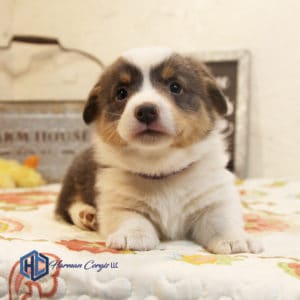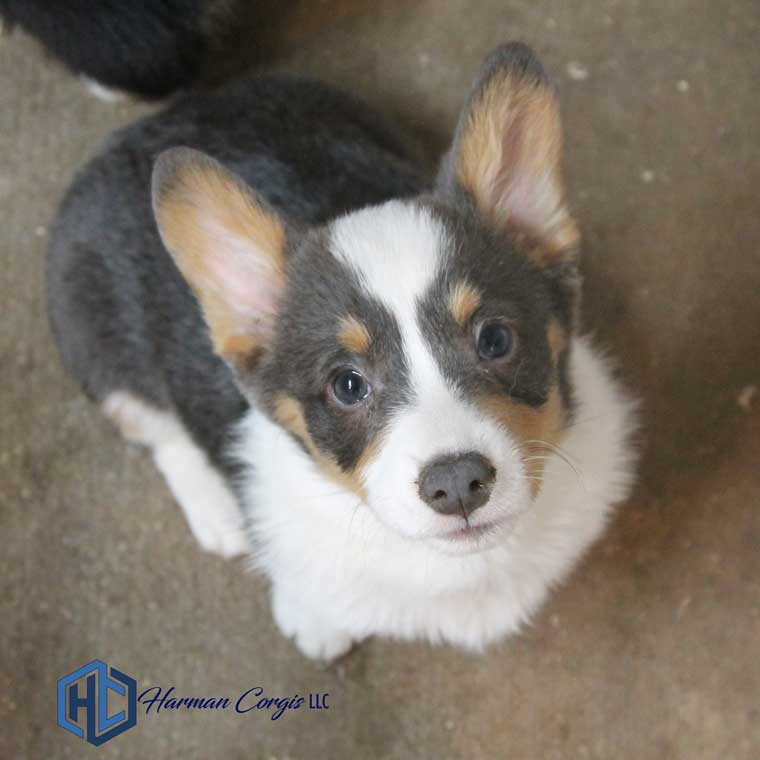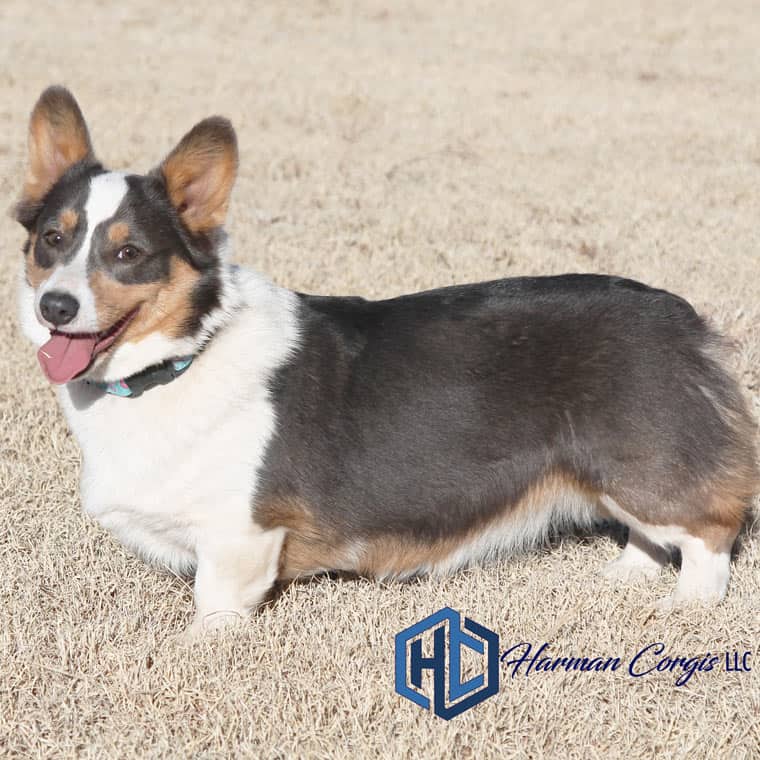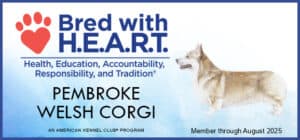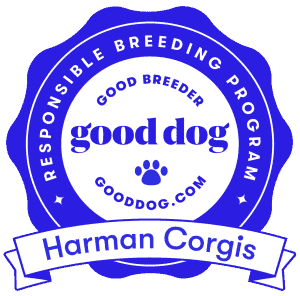Coat colors & color changes in Corgis
Home » Coat colors and color changes in Corgis
Recognized Colors in Pembroke Welsh Corgis
There are only 5 recognized standard coat colors in Pembroke Welsh Corgis. The color that a puppy appears to be may not be the final color when they mature. Working with an experienced breeder is the key to determining what color the dog will be as an adult. The 5 recognized standard coat colors in Pembroke Welsh Corgis are:
- Red
- Sable
- Fawn
- Red headed tricolor
- Black headed tricolor
They may or may not have white markings and there are variations on the standard colors.
Merles and brindles are NOT coat colors found in purebred Pembrokes. These colors are found in Cardigan Welsh Corgis or Corgi mix breeds. Learn more about these color differences on our Pembrokes, Cardigans and mixed dogs page.
Pembrokes may have a dilution gene (sometimes called the bluie gene) that washes out their color. These dogs are referred to as “Bluies”. Bluies may occur in all of the 5 Pembroke colors. Many people confuse “Bluies” with Merles but hey are two different things. Bluies are an accepted color but can not be shown in AKC or PWCCA shows while there is no such thing as a purebred Pembroke that is a merle. Those dogs are crosses NOT purebreds and can NOT be registered with AKC.
Other coats that you may see or terms that you may hear are fluffies (long hair) and mismarks (too much white). Both of these along with bluies are considered faults and these dogs can not be shown in AKC or PWCCA shows.
We raise purebred standard colored Pembroke Welsh Corgis however the fawn color is not a common color for us. From time to time we may also have bluies and an occasional fluffy.
Recognized Colors in Pembroke Welsh Corgis
Red Pembroke Welsh Corgi
- Body and head is red.
- Genetically red is the dominant color in Pembrokes. There are several variations of reds depending upon their genetics.
- Many times a dog who appears red will actually carry genes to produce sables or tris.
Sable Pembroke Welsh Corgi
- Body is red with black hairs on back.
- Hair around the edge of the ears is dark.
- There is a widows peak of dark hair on forehead.
- Sables are a variation of red where the second gene, tri color, is partially visible.
Fawn Pembroke Welsh Corgi
- Fawn is a light red color
Red Headed Tri-color (RHT) Pembroke Welsh Corgi
- Body has black hair and gradually blends into red or tan points.
- The back of the ears and head is red.
- Some red headed tris have a skull cap (darker area of hair on their head).
Black Headed Tri-color (BHT) Pembroke Welsh Corgi
- Body has black hair that does not blend into red and white points.
- The back of the ears and head is black.
- The edges of the ears are also black.
Diluted Colors or Bluies
Bluies occur when a dog inherits two copies of the dilution gene (one from each parent). In bluies, the normal coat color is “diluted” and appears washed out or diluted, i.e. tris dilute to gray. Any color can be diluted and the color is named for the animals base color for example, tri-color bluie. These colors are not as common as standard colors since both parents must carry the dilution gene.
Note that the Pembroke Welsh Corgi Club of America (PWCCA) considers diluted colors or bluies a fault and these dogs can not be shown at PWCCA or AKC shows.
From time to time we do produce bluies and can produce them in any color – tri bluies, sable bluies or red bluies. We normally breed standard colors however if you are interested in a blue, make sure to let us know on your getting to know you form and so we can plan litters with bluies.
Red Bluie Pembroke Welsh Corgi
- Born Gray
- Have a grayish – blue tinge to their coat.
- Eyes are a grayish blue or hazel color.
- Nose and eye liner will be gray.
- Can be registered with AKC under their primary color but can not be shown in AKC shows.
Sable Bluie Pembroke Welsh Corgi
- Born Gray
- Will be gray in color as puppies and have a gray-bluish tinge to hair as adults.
- Eyes will be a grayish blue or hazel.
- Nose and eye liner will be gray.
- Can be registered with AKC under their primary color but can not be shown in AKC shows.
Tri-color Bluies Pembroke Welsh Corgi
- Born Gray
- Their coat is a gray.
- Eyes will be a grayish blue or hazel.
- Nose and eye liner will be gray.
- Can be registered with AKC under their primary color but can not be shown in AKC shows.
- May be either red headed tri bluies or black headed tri bluies
Other colors & hair types that you may see
You may see purebred Pembroke Welsh Corgis with different markings or hair coats for sale. Common terms that you may see are:
- Whitelies: These dogs have too much white. Their body is mainly white with colored spots.
- Mismarks: These dogs have white that is located outside the allowable area.
- Fluffies: These dogs have long hair not the standard short coat.
Note that since the Pembroke Welsh Corgi Club of America (PWCCA) considers all of these breed faults, these dogs can not be shown at PWCCA or AKC shows. Nothing is wrong with any of these dogs except that their coloring or hair coat does not meet the breed standards set forth by the PWCCA. All of these dogs make excellent pets especially for people who want something a little different.
Remember that if you see a merle or brindle-colored Corgi that they are NOT purebreds. To learn more about the Cardigan Corgi breed or mixed breed dogs, visit our page on Pembrokes, Cardigans and mixed Corgis.
Coat Color changes in Corgis
The coat color in a Corgi puppy will dramatically change in color from the time that it is a puppy until it is an adult. Sometimes it is very hard to determine what color the dog will be as an adult but an experienced breeder will have a good idea about what color they will end up. Below we show you some pictures of coat color changes in Corgis through our own dogs.
Red and white
Sterling at Harman Corgis
Red Corgi puppies are born with redish or brownish fur on their bodies and dark areas around their eyes and ears.
As they grow the head is normally the first part of the body to lighten and turn red followed by the body.
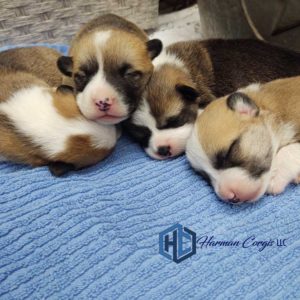
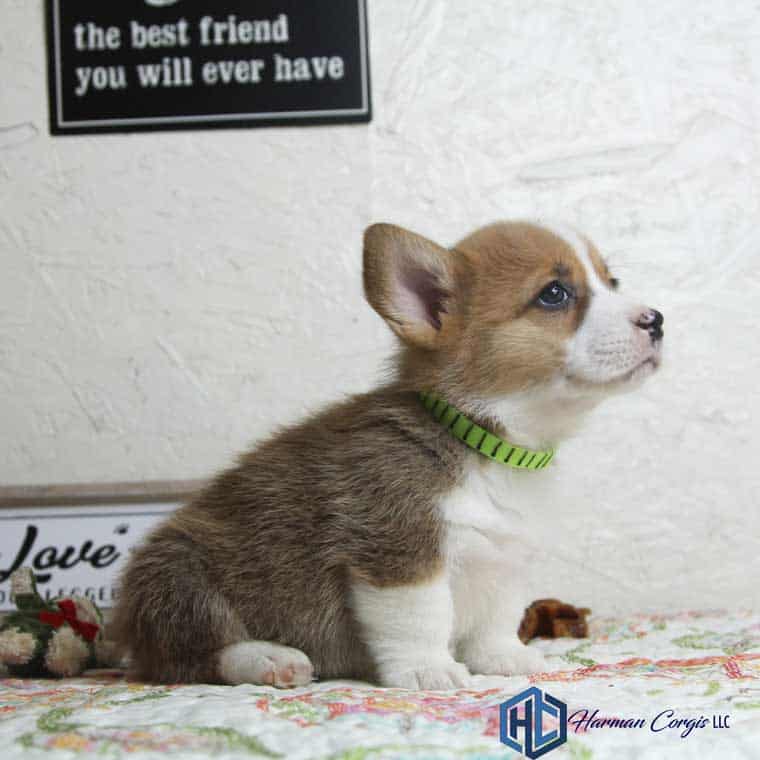

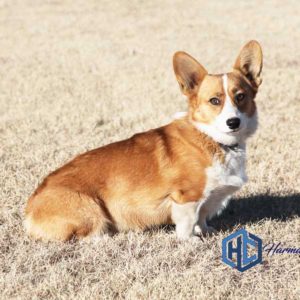
Sable
Benson at Harman Corgis
Sable puppies will have dark hair around the edges of their ears indicating they will probably be a sable.
As they grow, the body color lightens like a red colored pup but dark hairs start coming in under the ears and around the chest/shoulder/back area. The dark around the edge of the ears remain.
Mature dogs will have darker hair on their shoulders, back, around the edges of the ears and will have a fully formed widows peak on the head.
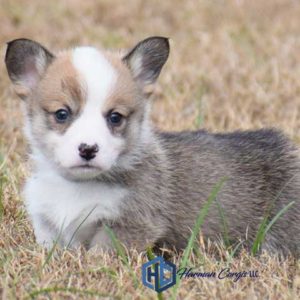
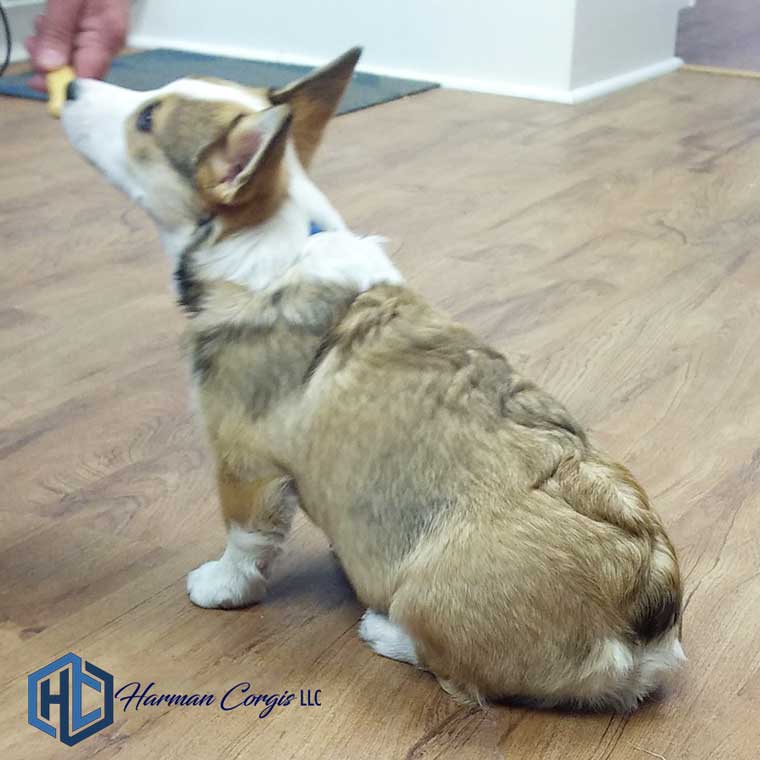
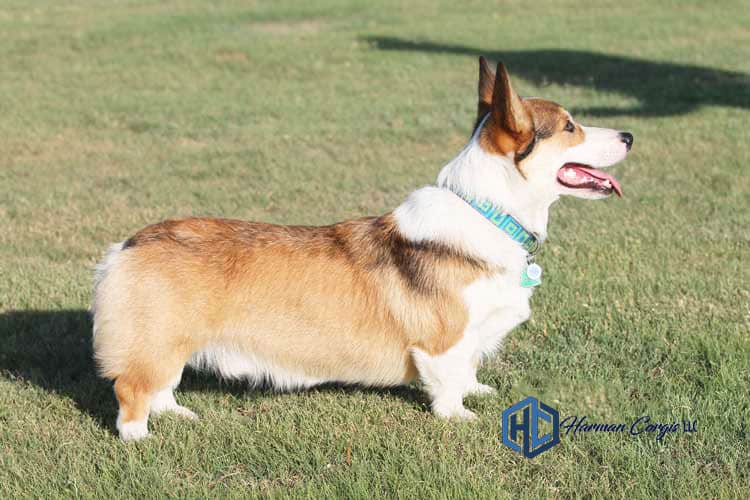
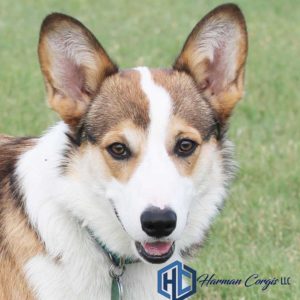
Red-headed Tri color
Lilac at Harman Corgis
Tri puppies start our life looking black and white with tiny red points. In red headed tris, the red points get much larger and the black blends into these areas.
One of the first changes that you see will be the back of the ears turning red indicating that the puppy will be a red headed tri.
The hair around the ears will also be red.
The hair on the head continues to loose black hairs and turn red until the head is basically all red. Note that the hair around the edge of the ear is red. The black also starts blending into the red pints on the body as the dog gets older.

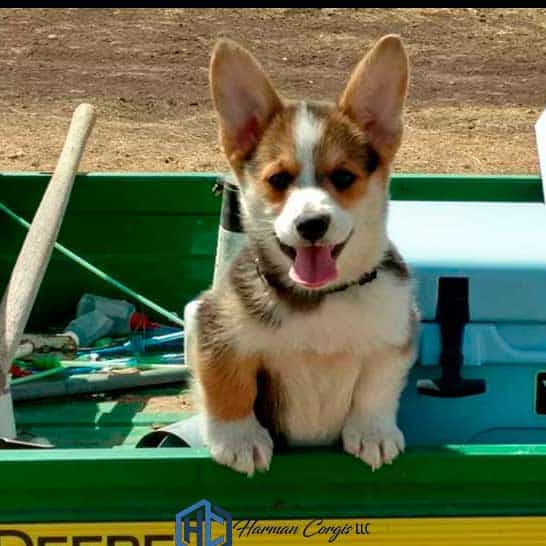
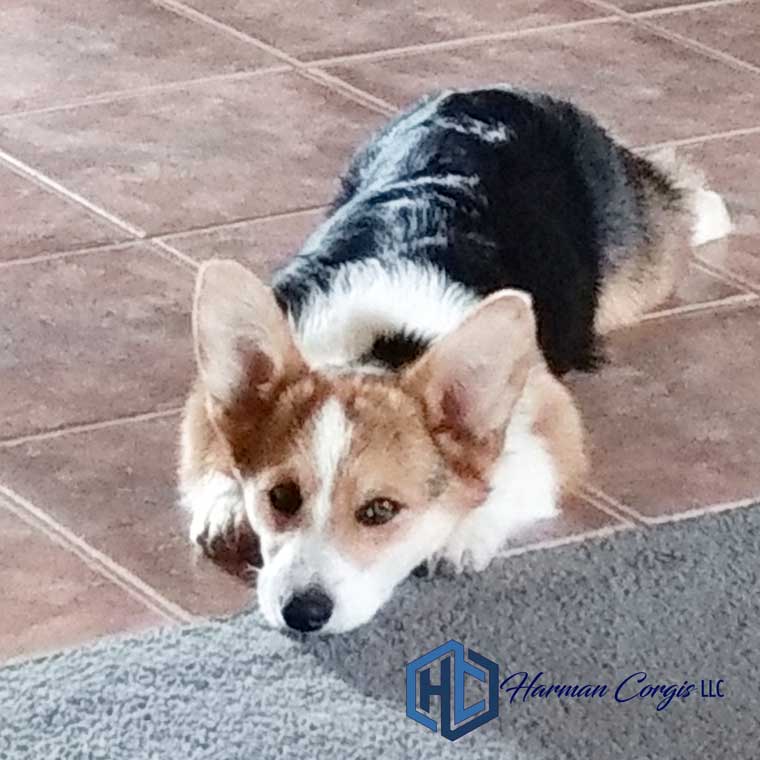
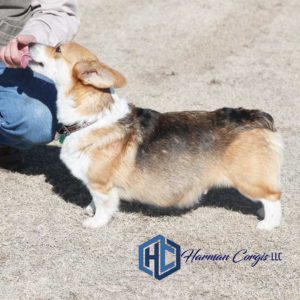
Red-headed Tri color with a skullcap
Barkley at Harman Corgis
Just like with full red headed tris, you will see black with red points.
The red points gradually become larger and the black begins to blend into the red points. The difference is that an area of black hair always remains on the head in front of the ears and does not turn red.
The hair around the edge of the ears will be red.
Note that the black saddle gets smaller as the dog ages as does the amount of white.

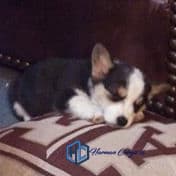

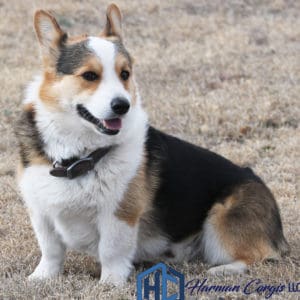
Note on Black Headed Tris - Look at the example of the BHT bluie below
Black headed tris will start out life being black with red points. As they grow you will notice several things.
1. The hair on the back of the ears will not change to red but will instead stay black.
2. The hair around the edge of the ears will be black and will stay black.
3. The red points gradually become larger but they will not blend into the black. Each color will have distinct boundaries.
Black headed tri bluie
Phoebe at Harman Corgis
This color progression would be the same for a black headed tri. The only difference is that on a blue, the hair is gray instead of black.
Just like with a red headed tri you see red points however this time, they do not blend into the gray but instead both colors have clear cut boundaries. The hair lining the ear is also dark.
